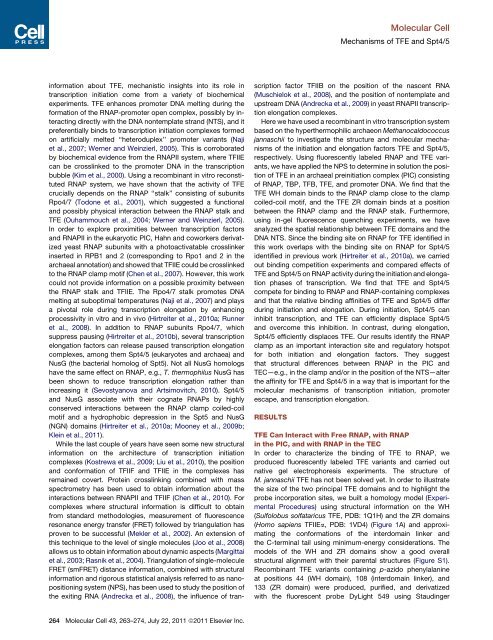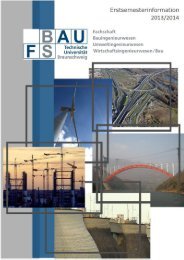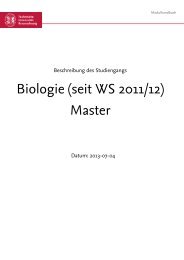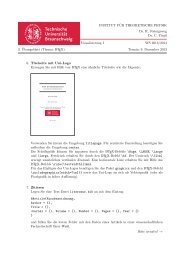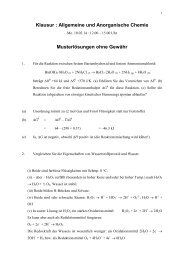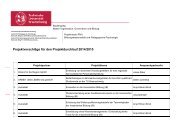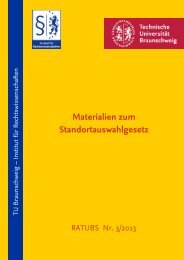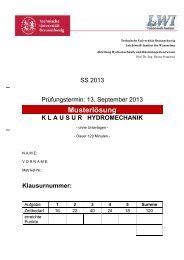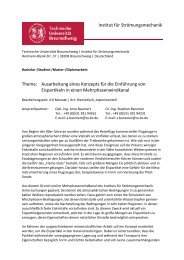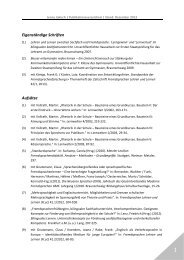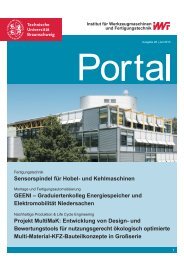L - Technische Universität Braunschweig
L - Technische Universität Braunschweig
L - Technische Universität Braunschweig
You also want an ePaper? Increase the reach of your titles
YUMPU automatically turns print PDFs into web optimized ePapers that Google loves.
Molecular Cell<br />
Mechanisms of TFE and Spt4/5<br />
information about TFE, mechanistic insights into its role in<br />
transcription initiation come from a variety of biochemical<br />
experiments. TFE enhances promoter DNA melting during the<br />
formation of the RNAP-promoter open complex, possibly by interacting<br />
directly with the DNA nontemplate strand (NTS), and it<br />
preferentially binds to transcription initiation complexes formed<br />
on artificially melted ‘‘heteroduplex’’ promoter variants (Naji<br />
et al., 2007; Werner and Weinzierl, 2005). This is corroborated<br />
by biochemical evidence from the RNAPII system, where TFIIE<br />
can be crosslinked to the promoter DNA in the transcription<br />
bubble (Kim et al., 2000). Using a recombinant in vitro reconstituted<br />
RNAP system, we have shown that the activity of TFE<br />
crucially depends on the RNAP ‘‘stalk’’ consisting of subunits<br />
Rpo4/7 (Todone et al., 2001), which suggested a functional<br />
and possibly physical interaction between the RNAP stalk and<br />
TFE (Ouhammouch et al., 2004; Werner and Weinzierl, 2005).<br />
In order to explore proximities between transcription factors<br />
and RNAPII in the eukaryotic PIC, Hahn and coworkers derivatized<br />
yeast RNAP subunits with a photoactivatable crosslinker<br />
inserted in RPB1 and 2 (corresponding to Rpo1 and 2 in the<br />
archaeal annotation) and showed that TFIIE could be crosslinked<br />
to the RNAP clamp motif (Chen et al., 2007). However, this work<br />
could not provide information on a possible proximity between<br />
the RNAP stalk and TFIIE. The Rpo4/7 stalk promotes DNA<br />
melting at suboptimal temperatures (Naji et al., 2007) and plays<br />
a pivotal role during transcription elongation by enhancing<br />
processivity in vitro and in vivo (Hirtreiter et al., 2010a; Runner<br />
et al., 2008). In addition to RNAP subunits Rpo4/7, which<br />
suppress pausing (Hirtreiter et al., 2010b), several transcription<br />
elongation factors can release paused transcription elongation<br />
complexes, among them Spt4/5 (eukaryotes and archaea) and<br />
NusG (the bacterial homolog of Spt5). Not all NusG homologs<br />
have the same effect on RNAP, e.g., T. thermophilus NusG has<br />
been shown to reduce transcription elongation rather than<br />
increasing it (Sevostyanova and Artsimovitch, 2010). Spt4/5<br />
and NusG associate with their cognate RNAPs by highly<br />
conserved interactions between the RNAP clamp coiled-coil<br />
motif and a hydrophobic depression in the Spt5 and NusG<br />
(NGN) domains (Hirtreiter et al., 2010a; Mooney et al., 2009b;<br />
Klein et al., 2011).<br />
While the last couple of years have seen some new structural<br />
information on the architecture of transcription initiation<br />
complexes (Kostrewa et al., 2009; Liu et al., 2010), the position<br />
and conformation of TFIIF and TFIIE in the complexes has<br />
remained covert. Protein crosslinking combined with mass<br />
spectrometry has been used to obtain information about the<br />
interactions between RNAPII and TFIIF (Chen et al., 2010). For<br />
complexes where structural information is difficult to obtain<br />
from standard methodologies, measurement of fluorescence<br />
resonance energy transfer (FRET) followed by triangulation has<br />
proven to be successful (Mekler et al., 2002). An extension of<br />
this technique to the level of single molecules (Joo et al., 2008)<br />
allows us to obtain information about dynamic aspects (Margittai<br />
et al., 2003; Rasnik et al., 2004). Triangulation of single-molecule<br />
FRET (smFRET) distance information, combined with structural<br />
information and rigorous statistical analysis referred to as nanopositioning<br />
system (NPS), has been used to study the position of<br />
the exiting RNA (Andrecka et al., 2008), the influence of transcription<br />
factor TFIIB on the position of the nascent RNA<br />
(Muschielok et al., 2008), and the position of nontemplate and<br />
upstream DNA (Andrecka et al., 2009) in yeast RNAPII transcription<br />
elongation complexes.<br />
Here we have used a recombinant in vitro transcription system<br />
based on the hyperthermophilic archaeon Methanocaldococcus<br />
jannaschii to investigate the structure and molecular mechanisms<br />
of the initiation and elongation factors TFE and Spt4/5,<br />
respectively. Using fluorescently labeled RNAP and TFE variants,<br />
we have applied the NPS to determine in solution the position<br />
of TFE in an archaeal preinitiation complex (PIC) consisting<br />
of RNAP, TBP, TFB, TFE, and promoter DNA. We find that the<br />
TFE WH domain binds to the RNAP clamp close to the clamp<br />
coiled-coil motif, and the TFE ZR domain binds at a position<br />
between the RNAP clamp and the RNAP stalk. Furthermore,<br />
using in-gel fluorescence quenching experiments, we have<br />
analyzed the spatial relationship between TFE domains and the<br />
DNA NTS. Since the binding site on RNAP for TFE identified in<br />
this work overlaps with the binding site on RNAP for Spt4/5<br />
identified in previous work (Hirtreiter et al., 2010a), we carried<br />
out binding competition experiments and compared effects of<br />
TFE and Spt4/5 on RNAP activity during the initiation and elongation<br />
phases of transcription. We find that TFE and Spt4/5<br />
compete for binding to RNAP and RNAP-containing complexes<br />
and that the relative binding affinities of TFE and Spt4/5 differ<br />
during initiation and elongation. During initiation, Spt4/5 can<br />
inhibit transcription, and TFE can efficiently displace Spt4/5<br />
and overcome this inhibition. In contrast, during elongation,<br />
Spt4/5 efficiently displaces TFE. Our results identify the RNAP<br />
clamp as an important interaction site and regulatory hotspot<br />
for both initiation and elongation factors. They suggest<br />
that structural differences between RNAP in the PIC and<br />
TEC—e.g., in the clamp and/or in the position of the NTS—alter<br />
the affinity for TFE and Spt4/5 in a way that is important for the<br />
molecular mechanisms of transcription initiation, promoter<br />
escape, and transcription elongation.<br />
RESULTS<br />
TFE Can Interact with Free RNAP, with RNAP<br />
in the PIC, and with RNAP in the TEC<br />
In order to characterize the binding of TFE to RNAP, we<br />
produced fluorescently labeled TFE variants and carried out<br />
native gel electrophoresis experiments. The structure of<br />
M. jannaschii TFE has not been solved yet. In order to illustrate<br />
the size of the two principal TFE domains and to highlight the<br />
probe incorporation sites, we built a homology model (Experimental<br />
Procedures) using structural information on the WH<br />
(Sulfolobus solfataricus TFE, PDB: 1Q1H) and the ZR domains<br />
(Homo sapiens TFIIEa, PDB: 1VD4) (Figure 1A) and approximating<br />
the conformations of the interdomain linker and<br />
the C-terminal tail using minimum-energy considerations. The<br />
models of the WH and ZR domains show a good overall<br />
structural alignment with their parental structures (Figure S1).<br />
Recombinant TFE variants containing p-azido phenylalanine<br />
at positions 44 (WH domain), 108 (interdomain linker), and<br />
133 (ZR domain) were produced, purified, and derivatized<br />
with the fluorescent probe DyLight 549 using Staudinger<br />
264 Molecular Cell 43, 263–274, July 22, 2011 ª2011 Elsevier Inc.


